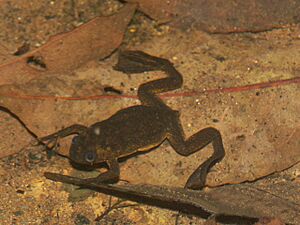Lake Oku clawed frog facts for kids
Quick facts for kids Lake Oku clawed frog |
|
|---|---|
 |
|
| Conservation status | |
| Scientific classification | |
| Genus: |
Xenopus
|
| Species: |
longipes
|
The Lake Oku clawed frog (Xenopus longipes) is a special type of frog. It belongs to the Pipidae family. This frog lives only in Lake Oku, a small crater lake in Cameroon, Africa. It is a small, dark frog that lives its whole life in water.
These frogs are about 28 to 36 millimeters (about 1 inch) long. Male frogs are a bit smaller than females. The International Union for Conservation of Nature says this frog is "critically endangered". This means it is in great danger of disappearing forever. It lives in only one small lake. If new fish are put into the lake, they could harm the frogs.
Meet the Lake Oku Clawed Frog
Lake Oku clawed frogs are quite small. Males usually grow to about 28–31 millimeters long. Females are a bit larger, reaching 32–36 millimeters. They get their name from the small claws on their back feet.
The frog's back is brown, and its belly has black spots on an orange background. These frogs are also special because they have many chromosomes. They have 12 sets, which is very unusual! They live entirely in water and are never seen outside the lake.
Where Do Lake Oku Clawed Frogs Live?
The Lake Oku clawed frog lives only in one place. This place is Lake Oku, a small crater lake. You can find this lake in the northwest part of Cameroon, a country in Africa.
Protecting the Lake Oku Clawed Frog
The Lake Oku clawed frog is in serious trouble. Experts have said it is "critically endangered" since 2004. They checked again in 2017 and it was still critically endangered. This is because it lives in only one small lake. There is also a risk that new types of fish could be put into the lake. These new fish might harm the frogs.
The lake and the forest around it are a special protected area. The government calls it a "Plantlife Sanctuary." A group called BirdLife International helped protect this area. They worked with the local community to save the forest and the lake.
Since 2006, scientists have been studying these frogs. They work with the local people of Oku. They also study the lake's environment. In 2013, the local community made a plan to protect Lake Oku. This plan helps save the lake, its forest, and animals like the Lake Oku clawed frog.
Some zoos are helping to save these frogs too. ZSL-London Zoo (UK) has had them since 2008. The Steinhart Aquarium in San Francisco, USA, has had them since 2013. The main goal is to have a group of frogs in zoos. This way, if the frogs disappear from the wild, they will still exist. In 2014, the frogs successfully had babies at the London Zoo!


